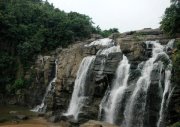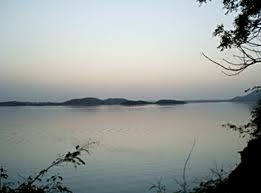HAZARIBAGH

Hazaribagh city lies in the state of Jharkhand. The word Hazaribagh comes from two words - ‘Hazar’ and ‘bagira’. ‘Hazar’ literally translates to ‘1000’ while ‘bagira’ translates to ‘cat’. Therefore, the literal meaning of the name of the city is the ‘city of 1000 cats’.
Hazaribagh was a cantonment from 1790 to 1884. Hazaribagh flourished under the British Rule and what resulted was a planned city. Today, that part of Hazaribagh is the Boddam Bazaar. Boddam Bazaar is named after the officer by whom it was planned.

The settlement of the Bengali community was another significant event during the British Rule in Hazaribagh in the 19th century. Some of the personalities which played a hand in shaping up Hazaribagh were Ray Bahadur Mukherjee, Manmathanath Dasgupta, Keshub Chander Sen and Rai Bahadur Surendra Nath Roy.
Ray Bahadur Mukherjee is credited with starting the Brahmo Samaj here and a lot of girls’ schools. Hazaribagh is also known to house some important educational institutions of the bygone era. Most of these institutions were started by the Dublin Mission, which worked with the support of Trinity College.

Coal reserves form the major chunk of revenue for this city. In fact, Hazaribagh has the second highest coal reserves in the state of Jharkhand. Coal mining has picked up speed in the recent past and a number of power projects have been undertaken by the government organisations like NTPC and Coal India Limited.
Hazaribagh has a cool climate, with summers being warm and the winters being cold. The temperature during the summer months hovers at about 30-32° Celsius. Other than being home to some important missionaries in the past, Hazaribagh has tourist attractions too.

Ray Bahadur Jadunath Mukhopadhay(Mukherjee) one of early settlers is much talked about. He was the first Government Pleader of Hazaribagh. His house in Hazaribagh Town played host to a galaxy of emminent persons including Sanjiv Chattopadhaya (of Palamau fame, Rabindranath Tagore and Subhas Chandra Bose. He helped in setting up the Durga Puja mandap, the Brahmo Samaj,the Keshav Hall/Union Club and Library and the first girls’ school in the town, which is now named after him.
Chanchala Niyogi physically got the school going around 1895. Those were the days when people thought that by educating their daughters they were paving the way for their widowhood. Around 1920, the new school building was built with the initiative of Braja Kumar Niyogi with funds mainly from the estate of Raja of Ramgarh. Great Scholars such as Mahesh Chandra Ghosh, and Dhirendranath Choudhury, made the town their home. The poet Kamini Roy lived in the town for some years.
Manmathanath Dasgupta, a Brahmo missionary spent many years in Hazaribagh working amongst the down trodden. Sarat Kumar Gupta contributed towards the development of the town in many ways. Doctors such as Mandindra Bhushan Banerjee (Panna Babu), Bikash Kumar Sen, Sambhu Nath Roy and Benoy Chandra Chatterjee were prominent personalities. The noted Bengali author and writer for many Hindi films like SUJATA, Subodh Ghosh was born and brought up in Hazaribagh. Many of his stories are set in the region.

Hazaribagh city lies in the state of Jharkhand. The word Hazaribagh comes from two words - ‘Hazar’ and ‘bagira’. ‘Hazar’ literally translates to ‘1000’ while ‘bagira’ translates to ‘cat’. Therefore, the literal meaning of the name of the city is the ‘city of 1000 cats’.
Hazaribagh was a cantonment from 1790 to 1884. Hazaribagh flourished under the British Rule and what resulted was a planned city. Today, that part of Hazaribagh is the Boddam Bazaar. Boddam Bazaar is named after the officer by whom it was planned.

The settlement of the Bengali community was another significant event during the British Rule in Hazaribagh in the 19th century. Some of the personalities which played a hand in shaping up Hazaribagh were Ray Bahadur Mukherjee, Manmathanath Dasgupta, Keshub Chander Sen and Rai Bahadur Surendra Nath Roy.
Ray Bahadur Mukherjee is credited with starting the Brahmo Samaj here and a lot of girls’ schools. Hazaribagh is also known to house some important educational institutions of the bygone era. Most of these institutions were started by the Dublin Mission, which worked with the support of Trinity College.

Coal reserves form the major chunk of revenue for this city. In fact, Hazaribagh has the second highest coal reserves in the state of Jharkhand. Coal mining has picked up speed in the recent past and a number of power projects have been undertaken by the government organisations like NTPC and Coal India Limited.
Hazaribagh has a cool climate, with summers being warm and the winters being cold. The temperature during the summer months hovers at about 30-32° Celsius. Other than being home to some important missionaries in the past, Hazaribagh has tourist attractions too.

Ray Bahadur Jadunath Mukhopadhay(Mukherjee) one of early settlers is much talked about. He was the first Government Pleader of Hazaribagh. His house in Hazaribagh Town played host to a galaxy of emminent persons including Sanjiv Chattopadhaya (of Palamau fame, Rabindranath Tagore and Subhas Chandra Bose. He helped in setting up the Durga Puja mandap, the Brahmo Samaj,the Keshav Hall/Union Club and Library and the first girls’ school in the town, which is now named after him.
Chanchala Niyogi physically got the school going around 1895. Those were the days when people thought that by educating their daughters they were paving the way for their widowhood. Around 1920, the new school building was built with the initiative of Braja Kumar Niyogi with funds mainly from the estate of Raja of Ramgarh. Great Scholars such as Mahesh Chandra Ghosh, and Dhirendranath Choudhury, made the town their home. The poet Kamini Roy lived in the town for some years.
Manmathanath Dasgupta, a Brahmo missionary spent many years in Hazaribagh working amongst the down trodden. Sarat Kumar Gupta contributed towards the development of the town in many ways. Doctors such as Mandindra Bhushan Banerjee (Panna Babu), Bikash Kumar Sen, Sambhu Nath Roy and Benoy Chandra Chatterjee were prominent personalities. The noted Bengali author and writer for many Hindi films like SUJATA, Subodh Ghosh was born and brought up in Hazaribagh. Many of his stories are set in the region.
Via.com being one of the India’s largest travel company is proud to announce the tie-up with RCB for the IPL 2012. On account of being the official sponsor the RCB players have the logo of Via.com on their respective helmets. Via.com is also coming out with the excellent travel offers which is one of a kind to set the travel domain on fire. For Information Please click on Via.com proud sponsor of RCB
No comments:
Post a Comment